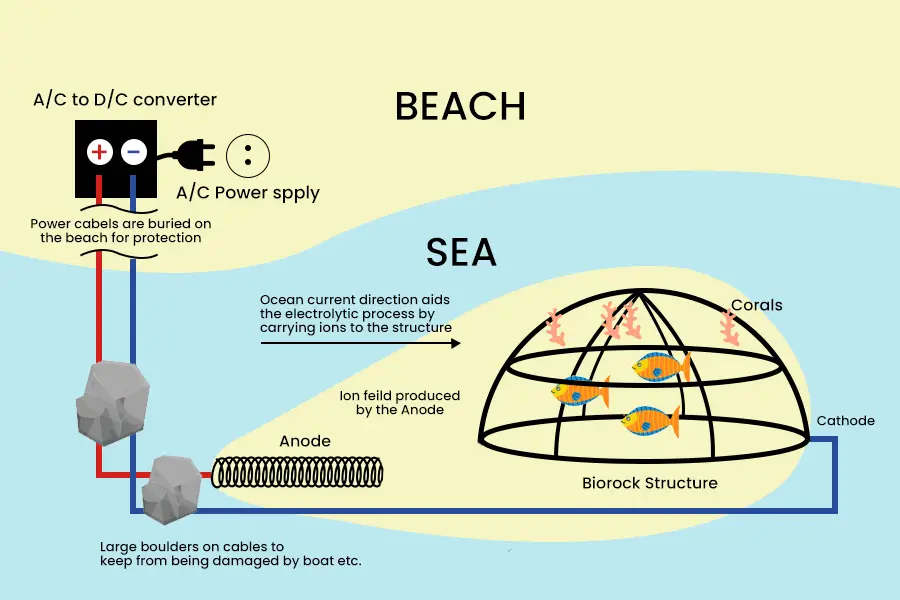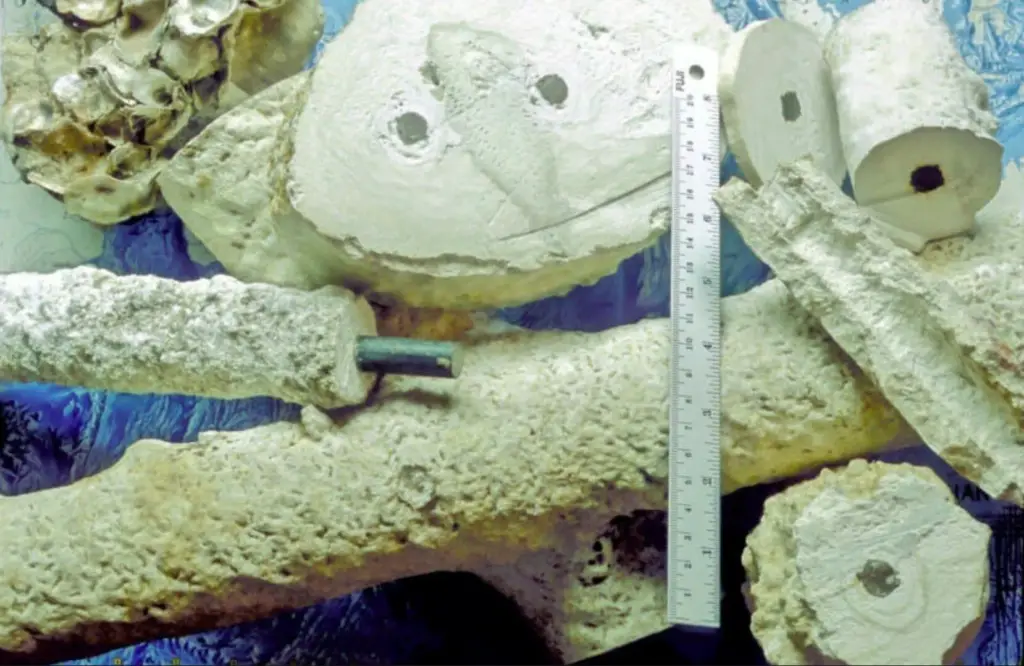Biorock technology serves as a safeguard for coral reefs, accomplished by creating rock-like substances beneath the ocean’s surface. This involves the application of an extremely low voltage electric current through the seawater, leading to the deposition of crystalline mineral salts previously dissolved in the water. The resultant crystals, primarily composed of calcium carbonate, amass to construct a structure akin to naturally formed coral reefs on the water’s bed.
Biorock technology has demonstrated successful applications beyond coral reefs, extending to fish and shellfish mariculture, as well as the reinforcement of limestone breakwaters to shield islands and coastal regions from the effects of erosion and the mounting sea levels.
This distinctive approach offers a means for diverse marine ecosystems—such as seagrass beds, salt marshes, mangroves, and oyster reefs—to not only endure but also rejuvenate in the face of damage stemming from excessive nutrients, climate fluctuations, and physical devastation. This is achieved by significantly enhancing marine organisms’ settlement, growth, durability, and resilience to various stressors, encompassing elevated temperatures and environmental pollutants.
Formation
Biorock technology engenders remarkable hard and sustainable marine structures, continually enhancing their strength. This characteristic distinguishes it from conventional underwater constructions susceptible to deterioration, demanding recurrent repairs or replacements. However, Biorock stands out for its exceptional trait of self-repair, facilitating the regeneration of any impaired or fractured section to reinstate the structure’s integrity. Over time, Biorock formations elevate in height, fostering the rapid growth of corals and oysters upon them.
Moreover, these formations contribute to shoreline preservation and avert the submersion of islands, particularly given the escalating sea level. Biorock structures offer cost-effective advantages, as they are more economical to erect than traditional concrete or rock counterparts but can also be reconfigured by incorporating materials to suit evolving requirements. Using Biorock has proven highly efficient in achieving desired outcomes swiftly and at a reduced expense.

History

Termed as “bio rock,” this resultant structure boasts exceptional strength and durability, providing an ideal habitat for corals to thrive. Biorock technology, a pioneering concept originating in 1976 by the esteemed architect and professor Wolf Hilbertz, aims to yield natural construction materials within marine environments. Unique to biorock materials is their ability to grow, fortify with age, and even undertake self-repair—a distinctive trait that Wolf referred to as Mineral Accretion Technology, Seacrete, or Seament.
Biorock Technology: Advantages and Potent Marine Management Solution
Biorock technology offers many advantages that surpass other alternatives in terms of efficacy, rapid outcomes, and cost-effectiveness. This innovative approach is a potent solution for addressing various critical marine management challenges.
1. Reviving and Safeguarding Coral Reefs in the Face of Global Warming
Biorock technology fosters the well-being and expansion of coral reefs, offering them favourable environments while enhancing their resilience against pollution. This technology aids specific marine species in recovering from harm and accelerating their growth. Through the Biorock process, optimal conditions are established for various marine life forms vulnerable to climate change and pollution. Corals flourishing on Biorock reefs enjoy increased prospects of survival when compared to those in other locations.

Utilizing Technology in India
In a pioneering endeavour, the Zoological Survey of India (ZSI), in collaboration with Gujarat’s forest department, is embarking on a ground breaking initiative to rejuvenate coral reefs through innovative biorock or mineral accretion technology in 2020
Mineral accretion technology
Referred to as ‘Biorock Technology,’ this approach involves gently applying low-voltage electrical currents within seawater. This process prompts dissolved minerals to undergo crystallization on surfaces, resulting in the development of a white limestone (CaCo3) akin to the natural composition of coral reefs and the pristine white sands found on tropical beaches.
In a pioneering move, a biorock framework was set up approximately one nautical mile from the Mithapur shoreline in the Gulf of Kachchh on January 19th, 2020. Notably, solar panels have been harnessed for power generation in this particular instance.
The calcification process, involving the transformation into calcium carbonate, has been initiated. However, the true achievement will be realized when the accelerated growth of connected and fresh organisms, specifically corals, becomes evident.
2. Safeguarding Marine Construction
The Biorock™ process leverages electrically conductive materials such as regular steel, which is widely used and cost-effective for construction purposes. This method enables the creation of structures in various sizes and shapes within marine environments. Through the utilization of Biorock™ technology, the steel components are shielded against corrosion. Initially, the rust on the steel transforms, transitioning from red to grey and black, ultimately reverting to iron.
Subsequently, the structure appears white as limestone minerals, naturally present in seawater, accumulate and grow over the surface. This gradual growth results in the development of a steadfast hard rock coating. When this material is cultivated gradually (approximately 1-2 centimeters per year), it attains a remarkable strength, around three times greater than concrete crafted from standard Portland cement.
3. Shore Protection
Biorock structures serve as effective breakwaters that harness the power of friction to impede the forceful progression of heavy water waves. This strategic approach significantly safeguards shorelines as the waves navigate these structures with reduced impact, mitigating erosion risk. Unlike conventional solid breakwaters, Biorock breakwaters avert the heightened scour and erosion often accompanying such structures.
These traditional breakwaters lead to the gradual depletion of sand in front of and underneath them, triggering processes like undermining, cracking, settling, and even collapsing. In contrast, Biorock breakwaters prevent the displacement of rock and concrete modules, which can otherwise be prone to separation during intense storms. This eliminates the need for costly crane-led reinstallation efforts and the cementation of massive units using limestone, further enhancing their durability and effectiveness.
4. Sustainable Aquaculture and marine life
- Beach erosion
- Coping with Rising Sea Levels
- Revitalizing Oyster Reefs
- Rejuvenation of Seagrass Beds
- Revitalization of Salt Marshes
- Fisheries Restoration
Biorock technology involves the creation of purpose-built structures that promote the well-being, expansion, and thriving environments of a diverse array of marine species. These innovative systems offer novel avenues for sustainable aquaculture by establishing conducive habitats and nourishment sources for marine life, such as fish, lobsters, and other underwater inhabitants. These systems contribute to fostering healthier marine ecosystems while supporting the cultivation of valuable marine resources.
In which of the following scenarios is “Biorock technology” utilized?
[A] Restoration of deteriorated coral reefs
[B] Utilization of plant residues for constructing materials
[C] Assessment of regions for shale gas exploration/extraction
[D] Provision of salt licks for wildlife in forests/protected zones
Restoration of deteriorated coral reefs
